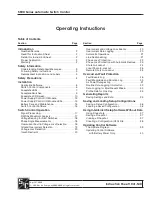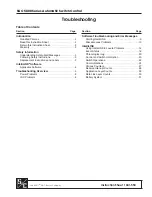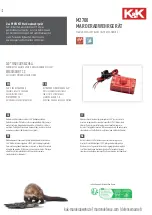
S38
230 Vac
21-09-2001
ZVL112.04
CARDIN
ELETTRONICA
spa
Via Raffaello, 36- 31020 San Vendemiano (TV) Italy
Tel:
+39/0438.404011-401818
Fax:
+39/0438.401831
email (Italy):
email (Europe):
Http:
www.cardin.it
Description
The
S38
Radio control system consists of one or more transmitters and one or more receivers
which can be combined to meet the specific needs of the client.
The receiver model offers the following possibilities: up to 4 channels and a number of pos-
sible combinations equal to 16384, (these are programmable through the use of a block of
14 two-way dip-switches).
Use
The
S38
radio control allows the remote activation of electrical and electronic appliances
with its best use in the following areas: motorized doors of all sizes, alarm systems, and in
all systems which require remote control activation.
The use and installation of these appliances must rigorously respect the indications supplied
by the manufacturer. The manufacturer accepts no liability for damage caused by, or situa-
tions arising from, the improper use of these appliances.
Compatibility
• The transmitters are fitted with a jumper "JC" (see drawings 3-4) to maintain
compatibility with with receivers of the series non "C".
- Jumper inserted:
Compatible with non series "C" receivers.
- Jumper not inserted: Compatible with series "C" receivers.
Transmitter versions
TRQ038200
Pocket size transmitters
2 channels
TRQ038400
Pocket size transmitters
4 channels
TRQ038800
Pocket size transmitters
8 channels
TRQ738200
Miniaturized transmitters
2 channels
TRQ738400
Miniaturized transmitters
4 channels
Receiver versions
RVQ038100
Re container
4 channels
RVQ03810C
Re container
4 channels
4-channel outdoor receivers IP55 (fig. 5)
The receiver is
in an outdoor cas
e fitted with a 12-way terminal board (printed circuit CS1304A/B)
with the following electrical connections:
230 Vac
between binding posts 1-2
Interchangeable channel modules
The interchangeable channel modules can only have the following configurations and must not
be mixed:
- from 1 to 4 impulsive relay strips
MCC4491R0
1 channel
- one ON-OFF relay strip
MCC0381M0
1 channel ON-OFF
- one timer relay strip
MCC0381T0
1 channel 0,5 to 120 seconds
Receiver installation
Depending on the type of installation, work out the position in which the programmer will be
situated remembering that the site must be:
- a position safe from accidental collision;
- high enough above the ground to be safe from pools of water;
- in a position which the technician can easily reach.
The fixing of the case type receiver is carried out by using "fast-fitting" brackets. The
bracket should be fixed to the wall using two raw plugs (check that it is plumb to the wall),
the case can then be slid onto the bracket and fastened securely to the wall. The slot-in
circuit located towards the bottom of the case can be easily extracted to facilitate wiring
up the device. If any repair work is necessary the case can be easily extracted by pushing
upwards the action of which will separate it from the bracket.
Electrical connection (fig. 5)
Before connecting the device to the mains make sure that:
- the voltage and frequency rated on the data plate conform to those of the mains supply;
- a bipolar circuit breaker which leaves at least
3 mm
between the contacts has been
installed between the device and the mains;
- the high voltage
230 V
wires pass through the holes marked "
A
" and are routed separately
from the low voltage wires which pass through the holes marked "
B
";
- the wires are fastened down using a cable clamp;
- once the wiring is complete the holes through which the wires have passed have been
sealed using silicon;
- the holes which are not used are sealed by inserting the sealing caps "
D
".
• Only low voltage circuits may be wired to the external circuit binding posts .
Receiver antenna installation
Minimum and maximum range of the radio controls. "Range" is intended to mean the working
distance, measured in free space, between the receiver and the transmitter with the antenna
installed. The range is therefore closely linked to the technical characteristics of the system (power
and sensibility) and varies according to the characteristics of the site in which the system is located.
It therefore follows that to obtain the best results from the radio control the installation sites for the
receiver and the antenna should be carefully chosen. It is not possible to install 2 receivers at a
distance of less than
1,5 m
from each other. It is good practise to position the receiver away from
computer systems, alarm systems and other possible sources of disturbance.
(A bad choice of positioning could compromise the performance of the receiver)
.
QUARTZ DIGITAL RADIO CONTROL WITH PROGRAMMABLE CODE 230V
Antenna
The installation of the antenna is fundamental; connected to the receiver it represents the reception
point for the radio control. When installing the antenna the following points should be observed:
- Only use a tuned antenna connected to the receiver using a coaxial cable
RG58
(impedance
50
Ω
) with a maximum length of
15 m
;
- The antenna should be positioned out of doors in the highest possible point, visible and away
from metal structures.
Note
: If for some particular reason it is not possible to fit an antenna, a reasonable performance can
be obtained by connecting a
2,5 m
piece of single pole conductor wire (
Ø1 mm
) to the receiver.
PROGRAMMING THE TRANSMITTER USER CODE
The transmitters and receivers are supplied with a block of DIP-SWITCHES (ON/OFF) with
which to program the digital codes for each system.
Programming can be carried out more than once, even after the installation, thus ensuring
the total secrecy of the user code.
A 14 way DIP-SWITCH with 16384 combinations is available for the programming of the
receiver and transmitter user codes in the 1 to 4 channel versions.
The use of transmitters with 8 keys allows code programming by means of a 13 way DIP-
SWITCH with 8192 combinations.
To ensure an exact match between the transmitter and receiver codes, when programming,
the following possibilities should be taken into consideration:
1) 2 and 4 key transmitters coupled with receivers with up to 4 channels.
Set the same code in both the receiver and the transmitter using all the available DIPS
(16384 possible combinations).
2) 8 key transmitters coupled with receivers with from 1 to 4 channels.
Set the transmitter code using 13 available DIPS. Set the same code in the receiver using
the first 13 the of the 14 available ; Dip number 14 is used to set the receiver to either the
first function group (14 ON = A,B,C,D) or the second function group (14 OFF = E,F,G,H).
It is important to remember that the receivers can only respond to one signal at a time.
IT FOLLOWS THEREFORE THAT MULTIPLE FUNCTIONS CANNOT BE USED CONTEMPORANEOUSLY.
RADIO CONTROL FUNCTIONS (fig. 2-3-4)
Function "A" of the two-button transmitter must always correspond to function "A" of
the receiver. For ease of identification we have divided the eight functions into two groups:
1st group: functions A,B,C,D,
2nd group: functions E,F,G,H.
The 8 key transmitters allow the use of functions belonging to both groups.
The 2 and 4 key transmitters as well the receivers with up to 4 channels (4 strips with one
relay each) use either only functions from the first group or only functions from the second
group. To choose between the two groups set the dip-switch nr. 14 as follows:
14 ON = Enables the functions of group one (A,B,C,D)
14 OFF = Enables the functions of group two (E,F,G,H).
2-4 CHANNELS TRANSMITTERS
In the transmitters each key corresponds to a different function, with the sole exception
of the two key transmitters where it is possible to have the same function for both keys.
(single-channel operation).
For double-channel operation which can be obtained using the second key, set the two-way
DIP switch, located separately from the fourteen-way user code dip-switch on the printed
circuit board (see fig. 2, 3 and 4).
1 TO 4 CHANNEL RECEIVER 230V (fig. 5)
In the receivers the channel functions are printed on the circuit board in silk-screen form. The
interchangeable slot-in STRIPS can therefore be inserted in the desired position.
Factory set for the insertion of four STRIPS with one relay each or
either one ON-OFF
module or one timer module
- If the receiver is coupled with a four key transmitter the user code in the receiver and
transmitter will ensure access to the correct function group. It is enough therefore to move
or insert one or more strips into the position which corresponds to the desired function.
- If instead, the receiver is coupled with an 8 key transmitter then it will be necessary
to set dip switch 14 in order to enable the functions of group one or group two as
the case may be and then move or insert one or more strips into the position which
corresponds to the desired function.
Take for example 2 receivers with 4 channels each, controlled by an 8 channel trans-
mitter.
As the transmitter can use functions from both groups whilst the receivers can only
use functions from one group one of the receivers will have to be set for the first group
(A,B,C,D = DIP14 on) and the other will have to be set for the second group (E,F,G,H
= DIP14 OFF).
After having set the receivers insert the strips as described above.
RECEIVER
- local oscillation frequency tolerance ................... 30 p.p.m. from -10° to +55°C
- intermediate frequency .......................................................................... 455 kHz
- antenna impedance in input .........................................................................50
Ω
- sensibility (fine signal) ................................................................................ 0.5µV
- local oscillation emission .....................................................<-70dBm (<100pW)
- power supply ........................................................................................ 230V ac
- maximum power consumption at rest .......................................................18mA
- maximum power consumption with activated relay ..................................20mA
- maximum commutable power at the relay with load in ac/dc .......... 60VA/24W
maximum voltage ..............................................................................30V ac/dc
- excitation delay/dropout delay ............................................................... 150 ms
TRANSMITTERS
- carrier frequency tolerance ................................... 30p.p.m. from -10° to +55°C
- band width .................................................................................. 10 kHz/± 5KHz
- apparent radiated power ........................................... -10...-7dBm (100-200µW)
- apparent power harmonic products ........................................<-64dBm (<1nW)
- power output adjacent channel (± 10 kHz) ...........................<-37dBm (<0.2µW)
- modulation .............................................................................................AM/ASK
- signal modulation ...................................................................... PCM, 1.3ms/bit
- power supply (Alkaline battery GP23A) ......................................... 9/12V ± 10%
- maximum power consumption ................................................................<38mA
- operating temperature range ......................................................... - 20… +70°C
- relative humidity.........................................................................................<95%
TECHNICAL SPECIFICATIONS
RECEPTION FREQUENCY
ATTENTION
The transmission frequency of these products varies
according to the approved frequency and eventual
personalisation in the country of destination.
Country
Frequency Antenna
Only Italy
30,875 MHz ANQ730
Europe
27,195 MHz ANQ727
USA
27,195 MHz ANQ727
The
S38
series conforms to the essential requirements of the directive
99/05/CE
and the technical reference standards have been applied. This product has been
tried and tested in the manufacturer's laboratory, during the installation of the pro-
duct follow the supplied indications carefully.
MODEL
DATE
SERIAL NUMBER
SERIES
























